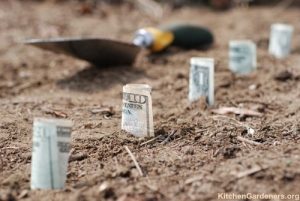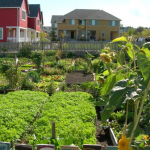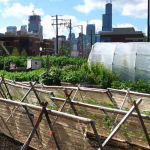Will a vegetable garden really save us money?
$3,465. What the average US family spent on ‘food in the home.’
$2,149. What a family saved by growing their own produce – in Maine.
And those are 2009 numbers, before energy prices started to climb.
If this syllogism is true . . .
If produce is cultivated with machinery then transported 1,500 miles, average, from where it’s grown to the grocery store;
And if most of America’s farm machinery and transportation runs on oil;
Therefore if oil prices rise, as predicted, food prices will rise.
 . . . does this mean our family can save money by growing some of our own food? Our accountant would say no. Even if oil quintupled in price, a cabbage from our home or community garden will still be more expensive than one shipped from a mechanized North Carolina farm. That’s because, while there’s lots of energy cost in the industrial cabbage, there’s even more labor cost in our backyard cabbage
. . . does this mean our family can save money by growing some of our own food? Our accountant would say no. Even if oil quintupled in price, a cabbage from our home or community garden will still be more expensive than one shipped from a mechanized North Carolina farm. That’s because, while there’s lots of energy cost in the industrial cabbage, there’s even more labor cost in our backyard cabbage
But most of us have labor to spare. The average American, remember, watches over 4 hours of TV a day. What we may not have is cash, particularly when an oil price hike has slowed the US economy.
And in cash terms, vegetable gardens can be big winners. Roger Doiron, the editor of Kitchen Gardeners, and his wife saved $2,149.15 at grocery store prices one year by producing 834 pounds of produce in their backyard. And that’s in the era of low energy prices.
And what about Roger and Jacqueline’s labor costs? “The cost of our labor is not included,” Roger says, “because we enjoy gardening and the physical work involved. If I am to include my labor costs, I feel I should also include the gym membership fees, country club dues, or doctors’ bills I didn’t have.”



